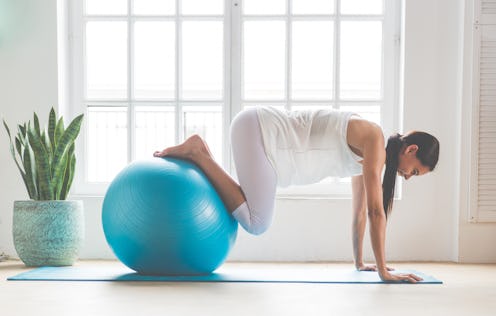Fitness
Beware Of Working-Out-From-Home Injuries
Don’t get hurt doing Zoom HIIT.

Even as gyms reopen with limited capacity and increased sanitation measures, working out from home remains the safest way to stay active and protect yourself from COVID-19. But some people are spraining ankles and twisting knees trying to get their sweat on in a less-than-professional space, and they're overworking muscle groups and breaking toes trying out new equipment without supervision. Even The Rock needed stitches after a home workout in his "Iron Paradise."
Dr. Robert Glatter, M.D., an emergency medicine physician at Lenox Hill Hospital, says that anecdotally, his ER has seen an increase of exercise-related injuries since the start of the pandemic.
"The public now runs a greater risk of potential injuries not only from a myriad of exercise equipment, but the dangers of working out at home as well," Dr. Glatter says. "The popularity of AR and VR devices places people at higher risk for sprains and fractures, along with head and neck injuries," Dr. Glatter says. Why? People are slipping on uneven flooring, bumping into nearby objects, and tripping over household items, leading to head injuries, cuts, or even fractures. He's seen a number of people seek medical attention for muscle strains or overuse from pushing themselves too hard at home. "The prolonged amount of time spent doing the exercise can even lead to muscle breakdown or rhabdomyolysis."
Though there's not significant data backing up pandemic-era workout-from-home injuries, there were over 450,000 exercise equipment-related injuries that resulted in a trip to the ER in 2019, according to the National Safety Council's injury facts survey. (Bowling, if you're curious, resulted in around 16,000 ER trips.) In May, the Washington Post reported that physical therapists were already bracing for a wave of injuries from both workout- and work-from-home setups.
But Dr. Glatter isn't discouraging people from working out at home. Instead, he asks that you take it more seriously, even if you're just doing a dance class in your living room. "If you purchase new exercise equipment, make sure you carefully read the instructions before using it," he says. Always warm up, wear sneakers, clean the floor, and stretch at the very least. "It’s also ideal to have a workout partner with you who can spot you — this can help to prevent injuries, but may also be lifesaving if you fall, injure yourself, or develop difficulty breathing, chest pain or dizziness in the setting of exercising," Dr. Glatter says.
According to Liz Letchford, Ph.D C., A.T.C, a coach at Tonal, an at-home free weight system that uses virtual assistance and AR technology, most free-weight related injuries come from over-training or incorrect form. "Where I often see improper form is in those last few, difficult reps where the muscles are fatigued and the body starts to compensate," Letchford tells Bustle. She adds that Tonal has built-in spotter technology that reduces resistance when the exerciser shows signs of struggle or fatigue, though of course that's not available for analog dumbbells (if you can even buy them). Even if you don't feel fatigued, your form might still increase your chance of injury. Recovery days between workouts are key to avoiding straining your muscles and joints.
While programs like Peloton, Nordic Track Fitness, Tonal, or the Mirror offer at home “coaching" as part of their draw to purchase the equipment — which many people have done while in quarantine — Dr. Glatter points out that "nothing replaces in-person instruction for optimal safety and guidance" when working out. "It’s important to be aware of this limitation when embarking on any home-based exercise program."
Source:
Dr. Robert Glatter, M.D., emergency medicine physician
Liz Letchford, Ph.D C., A.T.C, a coach at Tonal